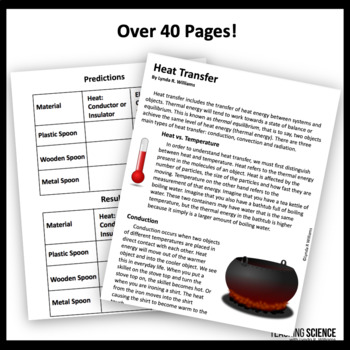Heat Transfer Activities - Convection Radiation and Conduction - Thermal Energy
- PDF
What educators are saying
Also included in
- This is a collection of labs and science experiments for chemical reactions and density. Enjoy this collection here at a 20% discount. Students will enjoy these hands-on colorful and engaging science experiments. This unit includes chemical reactions and density experiments.This resource includes HPrice $31.32Original Price $39.30Save $7.98
Description
Heat Transfer Unit: Students will learn about conductors, insulators, convection currents, conduction, and radiation in this heat transfer complete unit. Students will love making a solar oven among other hands-on experiments and heat transfer labs. This resource is a complete unit for teaching the concepts of heat transfer. It includes 4 labs and 2 additional engineering activities, a two-page informational text article explaining heat transfer, response pages, interactive notebook flaps, and more. Students will learn about conductors, insulators, convection currents, radiation, and conduction in heat transfer for middle school. Students will love the heat transfer lab and heat transfer foldable. Students will be using STEM engineering skills to create a tool related to heat transfer.
This unit is geared toward middle school science.
The following NGSS Disciplinary Core Ideas are addressed: Matter and Its Interactions and Energy.
This unit is aligned with NGSS standards for MS Physical science and is also aligned with Utah SEEd standards strand 6.2
NGSS Standards Addressed: .
MS-PS3-3. Apply scientific principles to design, construct, and test a device that either minimizes or maximizes thermal energy transfer
Utah SEEd standards addressed in this unit:
6.2.2 Develop a model to predict the effect of heat energy on states of matter and density. Emphasize the arrangement of particles in states of matter (solid, liquid, or gas) and during phase changes (melting, freezing, condensing, and evaporating).
6.2.4 Design an object, tool, or process that minimizes or maximizes heat energy transfer. Identify criteria and constraints, develop a prototype for iterative testing, analyze data from testing, and propose modifications for optimizing the design solution. Emphasize demonstrating how the structure of differing materials allows them to function as either conductors or insulators.
Science Concepts Addressed:
Conductors and Insulators
Thermal Energy
Convection
Conduction
Radiation
Design Thinking
Engineering
Heat transfer
Materials that Conduct or Insulate
Convection Currents
Thermal Equilibrium
This resource includes a reading passage and comprehension questions on heat transfer.
Science and Engineering Practices Students Will Use:
1. Asking questions (for science) and defining problems (for engineering)
2. Developing and using models
3. Planning and carrying out investigations
4. Analyzing and interpreting data
5. Constructing explanations (for science) and designing solutions (for engineering)
6. Engaging in argument from evidence
7. Obtaining, evaluating, and communicating information
Crosscutting Concepts:
Patterns
Cause and Effect
Scale, Proportion and Quantity
Energy and Matter
Structure and Function
Systems
Stability and Change
Please leave feedback on this resource. Feedback earns you valuable TPT credit that you can use for future resources.
Remember that leaving feedback earns you TPT points toward future purchases. Also, FOLLOW ME to be notified when new products are added. This is a huge bonus because my products are always 50% off for the first 24 hours they are posted
This resource is created by Lynda R. Williams. If you have questions about Teaching Science resources, please contact me at lywilliams1@gmail.com
Please look at some of my other science resources:






